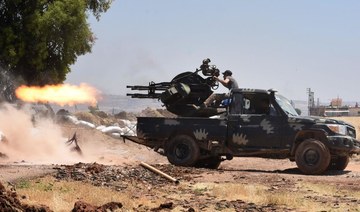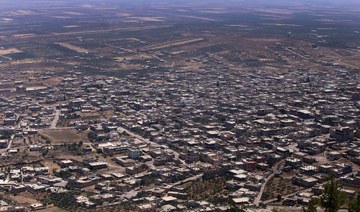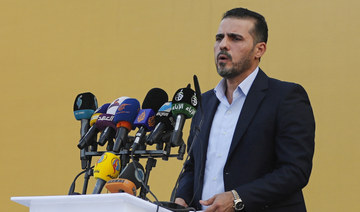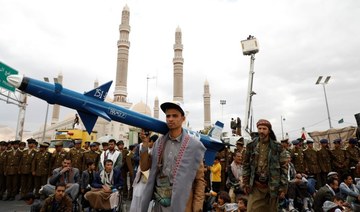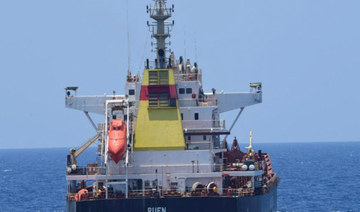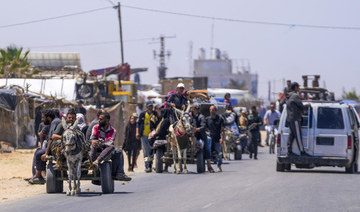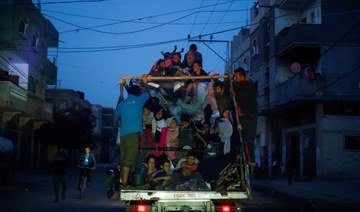BEIRUT: The latest strikes in the fiercest wave of regime bombardment on a militant enclave in northwestern Syria killed at least 15 civilians on Wednesday, a war monitor said, despite calls to halt the attacks.
Air strikes by Russian and government warplanes, some using barrel bombs, and shelling have claimed a mounting civilian death toll over the past few weeks.
The violence, which comes despite a truce deal brokered by Moscow and Ankara in September, has caused mass displacement and heightened fears of the worst humanitarian catastrophe in Syria's eight-year conflict.
The United States and the United Nations demanded an end to the bombardment on Tuesday, as strikes by Damascus killed 27 people -- the single highest civilian death toll in the region since the regime increased its attacks in late April.
But the aerial bombardment on Wednesday did not relent against Idlib province, most of which is controlled by Hayat Tahrir al-Sham, a group dominated by former members of Al-Qaeda's Syria affiliate.
According to the Britain-based Syrian Observatory for Human Rights monitoring organisation, seven of Wednesday's victims were killed in an air raid on the village of Sarja.
A father and his three children were killed in the village of Bara and four other civilians died in strikes in the towns of Hbeit and Areen, said Observatory chief Rami Abdel Rahman.
"The bombardment by the regime and Russia continues to be intense on several areas. The Russian strikes are focused on Khan Sheikhun but have not caused any casualties for now," he said.
Syrian state news agency SANA reported one woman was killed by militant shelling on northern Hama.
The civilian death toll has mounted in and around Idlib in recent days, reaching more than 270 over the past month, according to the Observatory.
In villages struck by regime raids, excavators have dug new graves and civilians buried the dead stealthily at dusk to avoid being targeted by more air raids.
Despite the surge in attacks the government has not announced an all-out offensive to retake the entire militant enclave, a large area which is home to almost three million people.
Analysts predict that President Bashar al-Assad and his allies will continue to chip away at the area but not unleash a major assault that would create chaos on Turkey's doorstep.
The regime is likely to continue applying sustained military pressure whilst attempting to preserve the fragile truce agreement reached in Russia last year to spare the region a large-scale humanitarian disaster.
On Tuesday, Syria's UN envoy Bashar Jaafari said Damascus "will spare no effort" to end the militant control of Idlib, according to comments carried by SANA.
UN deputy aid chief Ursula Mueller, however, told the Security Council that a further escalation would threaten humanitarian assistance for the region's residents.
She said some 270,000 people had been displaced by the fighting in Idlib since late April.
Aid agencies have been forced to suspend their work in some areas, she said.
At least 23 medical facilities have been hit since April 28, including two medical facilities that have been attacked twice, said David Swanson, a spokesman for the UN humanitarian office.
Five health workers have died and 7 others were injured as a result, he told AFP on Wednesday.
The United States has said that "indiscriminate attacks on civilians and public infrastructure such as schools, markets and hospitals is a reckless escalation."
The conflict in Syria has killed more than 370,000 people since it started in 2011.
Fresh strikes on Syria militant enclave kill 15
Fresh strikes on Syria militant enclave kill 15
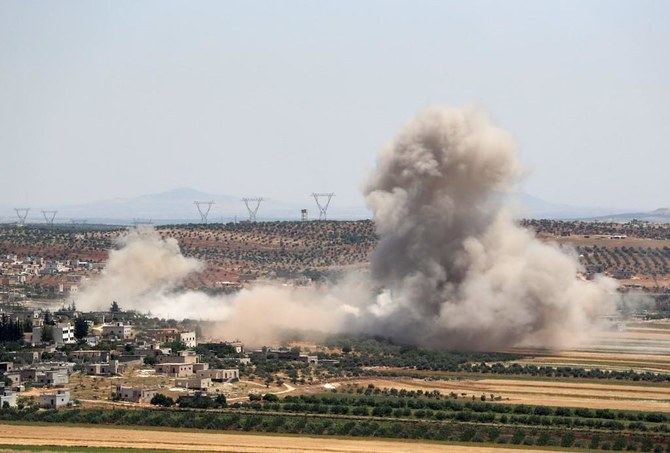
- At least 15 civilians were killed in a village in Idlib
- Most of Idlib province is controlled by a group dominated by ex-members of Al-Qaeda in Syria
Hamas says Gaza ceasefire efforts are back at square one

- Israel has killed more than 34,700 Palestinians, according to Gaza’s Health Ministry
CAIRO: The Palestinian militant group Hamas said on Friday that efforts to find a Gaza Strip truce deal were back at square one after Israel effectively spurned a plan from international mediators, and the White House said it was trying to keep the sides engaged “if only virtually.”
Hamas said in a statement it would consult with other Palestinian factions on its strategy for talks to halt seven months of war triggered by its deadly Oct. 7 attack on Israel.
Hours earlier, the United Nations warned that aid for Gaza could grind to a halt in days after Israel seized control this week of the Rafah crossing between Gaza and Egypt, a vital route for supplies to the devastated Palestinian enclave.
Despite heavy US pressure, Israel has said it will proceed with an assault on the southern Gaza city of Rafah, where more than 1 million displaced people have sought refuge and Israeli forces say Hamas militants are dug in.
Israeli tanks captured the main road dividing the eastern and western sections of Rafah, effectively encircling the eastern part of the city in an assault that has caused Washington to hold up delivery of some military aid.
The White House said that it was watching “with concern,” but the Israeli operations appeared to be localized around the shuttered Rafah crossing and did not reflect a large-scale invasion.
“Once again, we urge the Israelis to open up that crossing to humanitarian assistance immediately,” said White House national security spokesman John Kirby.
Israel’s plan for an all-out assault on Rafah has ignited one of the biggest rifts in generations with its main ally. Washington held up a weapons shipment over fears of massive civilian casualties.
In a report to Congress, President Joe Biden’s administration on Friday said it was reasonable to assess that Israel had used US arms in instances “inconsistent” with international humanitarian law.
However, the administration said it still found credible and reliable Israel’s assurances that it will use US weapons in accordance with international humanitarian law.
Indirect diplomacy has failed to end a war that health authorities in Hamas-run Gaza say has killed almost 35,000 people since the Oct. 7 attack. Some 1,200 people were killed in Israel and 253 taken hostage on Oct. 7, according to Israeli tallies.
Ceasefire talks in Cairo broke up on Thursday with no agreement.
Hamas had said it agreed at the start of the week to a proposal by Qatari and Egyptian mediators that had previously been accepted by Israel. Israel said the Hamas proposal contained elements it cannot accept.
“Israel’s rejection of the mediators’ proposal through the amendments it made returned things to the first square,” Hamas said in Friday’s statement.
“In the light of (Israel Prime Minister Benjamin) Netanyahu’s behavior and rejection of the mediators’ document and the attack on Rafah and the occupation of the crossing, the leadership of the movement will hold consultations with the brotherly leaders of the Palestinian factions to review our negotiation strategy.”
“Hamas did not suspend nor withdraw from the negotiations; the occupation (Israelis) turned against the mediators’ proposal,” a senior Hamas official, Khalil Al-Hayya, said in comments to Al Araby TV published by Hamas.
Kirby said the end of the talks — which CIA Director William Burns was helping mediate — was “deeply regrettable,” but the US believed the differences were surmountable.
“We are working hard to keep both sides engaged in continuing the discussion, if only virtually,” he said.
EXPLOSIONS AND GUNFIRE
Residents described almost constant explosions and gunfire east and northeast of Rafah on Friday, with intense fighting between Israeli forces and militants from Hamas and Islamic Jihad.
Hamas said it ambushed Israeli tanks near a mosque in the east of the city, a sign the Israelis had penetrated several kilometers from the east to the outskirts of the built-up area.
Israel has ordered civilians out of the eastern part of Rafah, forcing tens of thousands of people to seek shelter outside the city, previously the last refuge of more than a million who fled other parts of the enclave during the war.
Israel says it cannot win the war without assaulting Rafah to root out thousands of Hamas fighters it believes are sheltering there. Hamas says it will fight to defend it.
Supplies were already running short and aid operations could halt within days as fuel and food stocks get used up, UN aid agencies said.
“For five days, no fuel and virtually no humanitarian aid entered the Gaza Strip, and we are scraping the bottom of the barrel,” said the UNICEF Senior Emergency Coordinator in the Gaza Strip, Hamish Young.
Aid agencies say the battle has threatened hundreds of thousands of displaced civilians.
“It is not safe, all of Rafah isn’t safe, as tank shells landed everywhere since yesterday,” Abu Hassan, 50, a resident of Tel Al-Sultan west of Rafah told Reuters via a chat app.
“I am trying to leave but I can’t afford 2,000 shekels ($540) to buy a tent for my family,” he said. “There is an increased movement of people out of Rafah even from the western areas, though they were not designated as red zones by the occupation.”
Israeli tanks have sealed off eastern Rafah from the south, capturing and shutting the only crossing between the enclave and Egypt. An advance on Friday to the Salahuddin road that bisects the Gaza Strip completed the encirclement of the “red zone” where they have ordered residents out.
The Israeli military said its forces in eastern Rafah had located several tunnel shafts, and troops backed by an air strike fought at close quarters with groups of Hamas fighters, killing several.
It said Israeli jets had hit several sites from which rockets and mortar bombs had been fired toward Israel.
The UN General Assembly overwhelmingly backed a Palestinian bid to become a full UN member by recognizing it as qualified to join and recommending the UN Security Council “reconsider the matter favorably.”
Iranians vote in parliamentary runoff election

- Politicians calling for change in the country’s government, known broadly as reformists, were generally barred from running in the election
TEHRAN: Iranians voted on Friday in a runoff election for the remaining seats in the country’s parliament after hard-line politicians dominated March balloting.
People in 22 constituencies across the country will elect 45 representatives from a pool of 90 candidates, 15 of whom are considered moderate.
In the capital, Tehran, 16 representatives will be chosen from 32 candidates, all hard-liners.
Final results are expected on Monday, though counts in smaller constituencies are likely before that.
Iran’s parliament plays a secondary role in governing the country.
Supreme Leader Ali Khamenei has the final say in all important state matters.
State TV showed Khamenei voting on Friday immediately after the polls opened.
He urged people to vote and said the runoff election was as important as the main one.
In the March election, hard-liners won 200 out of 245 seats, with more moderate candidates taking the other 45. A total of 25 million ballots were cast, for a turnout of just under 41 percent.
The previous lowest turnout was 42 percent in the 2020 parliamentary election.
Politicians calling for change in the country’s government, known broadly as reformists, were generally barred from running in the election.
Those calling for radical reforms or for abandoning Iran’s theocratic system were also banned or did not bother to register as candidates.
Suspected pirate attack in Gulf of Aden raises concerns about growing Somali piracy

- Somali piracy in the region at the time cost the world’s economy some $7 billion — with $160 million paid out in ransoms, according to the Oceans Beyond Piracy monitoring group
DUBAI: A European naval force detained six suspected pirates on Friday after they opened fire on an oil tanker traveling through the Gulf of Aden, officials said, likely part of a growing number of piracy attacks emanating from Somalia.
The attack on the Marshall Islands-flagged Chrystal Arctic comes as Houthis have also been attacking ships traveling through the crucial waterway, the Red Sea, and the Bab Al-Mandeb Strait connecting them.
The assaults have slowed commercial traffic through the key maritime route onward to the Suez Canal and the Mediterranean Sea.
The pirates shot at the tanker from a small ship “carrying weapons and ladders,” according to the British military’s UK Maritime Trade Operations Center, which oversees Mideast shipping routes.
The pirates opened fire first at the Chrystal Arctic, whose armed onboard security team returned fire at them, the UKMTO said.
BACKGROUND
Maritime sources say pirates may be encouraged by a relaxation of security or may be taking advantage of the chaos caused by attacks on shipping by the Houthis.
The pirates then abandoned their attempt to take the tanker, which continued on its way with all its crew safe, the UKMTO said.
Hours later, the EU naval force in the region known as Operation Atalanta said a frigate operating in the region detained six suspected pirates.
The frigate seized the pirates, given “the unsafe condition of their skiff” and said that some had “injuries of varied severity.”
It was not immediately clear if those injured suffered gunshot wounds from the exchange of fire with the Chrystal Arctic.
The EU force declined to elaborate “due to the security of the operations.”
Once-rampant piracy off the Somali coast diminished after a peak in 2011. That year, there were 237 reported attacks in waters off Somalia.
Somali piracy in the region at the time cost the world’s economy some $7 billion — with $160 million paid out in ransoms, according to the Oceans Beyond Piracy monitoring group.
Increased naval patrols, a strengthening central government in Mogadishu, Somalia’s capital, and other efforts saw the piracy beaten back.
However, concerns about new attacks have grown in recent months.
According to the International Maritime Bureau, five incidents were reported off Somalia in the first quarter of 2024.
“These incidents were attributed to Somali pirates who demonstrate mounting capabilities, targeting vessels at great distances from the Somali coast,” the bureau warned in April.
It added that there had been “several reported hijacked dhows and fishing vessels, which are ideal mother ships to launch attacks at distances from the Somali coastline.”
In March, the Indian navy detained dozens of pirates who seized a bulk carrier and took its 17 crew hostage.
In April, pirates release 23 crew members of the Bangladesh-flagged cargo carrier MV Abdullah after seizing the vessel.
The terms of the release are not immediately known.
These attacks come as the Houthi campaign has targeted shipping since November as part of their pressure campaign to stop the Israel-Hamas war raging in the Gaza Strip.
Israeli troops drive further into Rafah as tanks split city in two

- Four Israeli soldiers killed as Hamas and Islamic Jihad put up a fierce resistance
- Israel’s move into Rafah has been short of the full-scale invasion that it threatened
JEDDAH: Israeli troops pushed further into Rafah in southern Gaza on Friday as its tanks split the city in two and encircled the eastern half.
The Israeli forces faced fierce resistance from Hamas and Islamic Jihad fighters, and battles also resumed in northern Gaza, where Hamas has regrouped after being forced out earlier in the war. Four Israeli soldiers were killed in fighting there.
Israel’s move into Rafah has been short of the full-scale invasion that it threatened. The US and other Israeli allies are deeply opposed to a major offensive, and Washington has threatened to hold back arms to shipments to Israel.
But the heavy fighting has shaken the city and spread fear that a bigger assault is coming.
The UN agency for Palestinian refugees said more than 110,000 people had fled Rafah, and families who had already moved numerous times during the war were doing so again.
“The full invasion hasn’t started and things have already gotten below zero,” said Raed Al-Fayomi, a refugee in Rafah. “There’s no food or water.”
Those fleeing erected new tent camps in Khan Younis, which was half destroyed in an earlier Israeli offensive, and the town of Deir Al-Balah.
The charity Project Hope said there had been a surge in people from Rafah seeking care for blast injuries, infections and pregnancies in its clinic in Deir Al-Balah.
“People are evacuating to nothing. There are no homes or proper shelters for people to go to,” said the group’s Gaza team leader in Rafah, Moses Kondowe.

UN aid official Georgios Petropoulos said humanitarian workers had no supplies to set up in new locations.
“We simply have no tents, we have no blankets, no bedding, none of the items that you would expect a population on the move to be able to get from the humanitarian system,” he said.
The fighting in Rafah has left crucial nearby aid crossings inaccessible, and food and other supplies were running critically low, aid agencies said.
The World Food Program will run out of food for distribution in southern Gaza by Saturday, Petropoulos said.
Aid groups have said fuel will also be depleted soon, forcing hospitals to shut down critical operations and bringing to a halt trucks delivering aid across south and central Gaza.
US report criticizes Israel but does not block arms

- The report said it was “reasonable to assess” that Israel has used weapons in ways inconsistent with international humanitarian law
- The report had been held up for several days by debate within the US State Department
WASHINGTON: A long-awaited State Department report on Friday criticized Israel’s use of US weapons in the Gaza war but did not find enough evidence of violations to block shipments.
The report said it was “reasonable to assess” that Israel has used weapons in ways inconsistent with international humanitarian law but that the United States could not reach “conclusive findings.”
The report had been held up for several days by debate within the State Department and was finally released after President Joe Biden publicly threatened to withhold certain bombs and artillery shells from Israel if it goes ahead with an assault on the packed city of Rafah.
The report does not affect that decision, with the White House reiterating on Friday that it was concerned about Israeli military action around Rafah, where some 1.4 million Palestinians have taken shelter.
Biden, responding to critics within his Democratic Party concerned by the toll on civilians in the Gaza war, had in February issued a memorandum known as NSM-20 that asked countries that receive US military aid to make “credible and reliable” assurances they are complying with human rights laws.
Israel — which launched a war against Hamas after the militants staged the deadliest ever attack on the country on October 7 — made assurances to the United States and “identified a number of processes for ensuring compliance that are embedded at all levels of their military decision-making,” said the public version of the report, which was submitted to Congress.
“The nature of the conflict in Gaza makes it difficult to assess or reach conclusive findings on individual incidents,” it said.
“Nevertheless, given Israel’s significant reliance on US-made defense articles, it is reasonable to assess that defense articles covered under NSM-20 have been used by Israeli security forces since October 7 in instances inconsistent with its IHL obligations or with established best practices for mitigating civilian harm,” it said, referring to international humanitarian law.
The report also said that while the Israeli Defense Forces have “the knowledge, experience and tools” to minimize harm, “the results on the ground, including high levels of civilian casualties, raise substantial questions as to whether the IDF is using them effectively in all cases.”
But despite some “serious concerns,” the report said that all countries receiving US military aid had made assurances credible and reliable enough “to allow the provision of defense articles covered under NSM-20 to continue.”
A US official described the report as a snapshot and said the State Department was still monitoring the use of weapons.
The other recipients of US military aid covered by the report were Colombia, Iraq, Kenya, Nigeria, Somalia and Ukraine.



